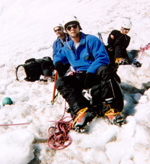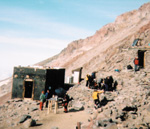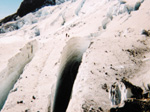Reaching for a Mountain High
We all have mountains to climb. Snow, jagged rocks, ice, and giant
hidden crevices cover Jason Ferro’s mountains.
 Ferro
and friends take a break.
Ferro
and friends take a break.
A nurse in MUSC’s Hospital Options Pool (HOP), Ferro usually works in the Post Anesthesia Care Unit. He graduated from the College of Nursing six years ago and fell in love with mountain climbing, or mountaineering, about two years ago.
“I was traveling around the country as an R.N. and ended up in California for a few months. People were so outdoorsy, there were so many climbers,” Ferro said.
At first, Ferro would barely entertain the idea of climbing.
Soon he found himself in the company of a good book, “Into Thin Air,” by John Krackhaur. Ferro describes his climbing enthusiasm at this point as his “armchair mountaineer” stage.
“After I read the book, I was hooked,” Ferro said. “I talked to a buddy
of mine, Gene Sides, about climbing with me. At first he just shook his
head, but after a few
minutes he was gung ho.”
He loved reading about it, watching climbers on TV, and then slowly his fascination began to evolve into motivation.
Ferro’s first adventure was to scale Mount Ranier’s 14,400 foot summit outside of Seattle. Ferro and his buddy began the climb on Sept. 14, 2001. “Since it was my first climb, they teach you along the way. You take courses as you go, like rescue procedures,” he said.
 Ferro
scales the side of a giant glacier on the side of Mount Ranier.
Ferro
scales the side of a giant glacier on the side of Mount Ranier.
And it was a good thing that they taught Ferro and his fellow climbers about rescue work. Right after a guide had finished instructing the group on how to react to a fall from an unexpected cliff or crack in a glacier, one of the group members actually fell through a snow-covered crack in the side of the mountain.
“It was a very sobering experience,” Ferro said.
 A
“luxurious” base camp located on the side of Mount Ranier. These camps
are scattered throughout the lower levels of the mountain.
A
“luxurious” base camp located on the side of Mount Ranier. These camps
are scattered throughout the lower levels of the mountain.
A veteran hiker and camper, Ferro admits that climbing is a challenge. The group had to spend a day or two at 5,000 feet and then at 10,000 feet in order to acclimate to the weather and altitude changes.
“I did get a little bit of altitude sickness, but the whole point of doing something like this is to get to the top. You can’t just quit,” Ferro said. But hiking the Blue Ridge or the Smokies isn’t enough when it comes to preparing for a major climb. “So much preparation goes into a trip like this, “ Ferro said. “Everything has to be considered, from the weather forecast to food and gear.”
 Ferro
and his companions awoke to quite a suprise one morning upon realizing
that the path they’d walked the evening before was lined by two huge crevices
in the snow and ice. The footprints of the group file a single line between
the giant cracks.
Ferro
and his companions awoke to quite a suprise one morning upon realizing
that the path they’d walked the evening before was lined by two huge crevices
in the snow and ice. The footprints of the group file a single line between
the giant cracks.
Ferro suggests that if someone is interested in climbing a mountain like Mount Rainier, then physical conditioning like working out, running, or biking is essential.
 With
a reward like this, who wouldn’t want to climb a mountain? Ferro snaps
a photo to capture the feeling of rising above the clouds to conquer a
major peak.
With
a reward like this, who wouldn’t want to climb a mountain? Ferro snaps
a photo to capture the feeling of rising above the clouds to conquer a
major peak.
An individual needs to be in excellent cardiovascular shape before attempting to climb in high altitudes.
“You have to be financially ready as well. It cost $1,500 to buy and rent my equipment, not to mention paying for the guide, food, etc.,” Ferro said.
Speaking of guides, Ferro said a climber must submit a “climbing resume” to several guides before going on a trip. Some guides prefer to work with experts, while others prefer to teach novices.
In terms of equipment, when Ferro climbed Mount Rainier, he had a Gore-Tex fleece, which is made from polypropylene, a quick-drying, breathable material. Perfect for scaling a mountain, especially when you’re not sure what the weather will be like at 14,000 feet.
Ferro also wore plastic boots similar to ski boots with metal teeth on the bottoms for gripping the ice.
“You’ve got to have your glacier goggles or sunglasses as well,” Ferro said. “The UV exposure is so intense because of the reflection off the snow that you can go snow-blind.”
Ferro said he was a real redneck during his trip, as he was sunburned on the underside of his chin and neck from the reflection off the snow.
Climbers are responsible for carrying packs containing everything that they’ll need for several days, including clothing and dehydrated food. The climbers melt snow for water along the way.
Ferro said that a mountain in Ecuador next July seemed like a possibility. “I think that I’d even like to hike and climb the North Pole some day,” he said.
The only thing that Ferro has to worry about is getting the finances together to make it happen. Tracey, his wife of a little over a month, is supportive of his adventurous spirit.
“If I can raise the money to climb Mount Everest, she’ll let me,” Ferro said.
Story by Heather Murphy, photos provided by
Jason Ferro.
ON the SIDE
MUSC is full of people who do extraordinary things, both at work and “On the Side.” Whether it's climbing a mountain or volunteering in the community, we'd like to know what these folks are up to when they leave the campus. If you know of someone who should be featured in this monthly section, call Heather Murphy at 792-3621 or e-mail murphyhl@musc.eduCatalyst Online is published weekly, updated as
needed and improved from time to time by the MUSC Office of Public Relations
for the faculty, employees and students of the Medical University of South
Carolina. Catalyst Online editor, Kim Draughn, can be reached at 792-4107
or by email, catalyst@musc.edu. Editorial copy can be submitted to Catalyst
Online and to The Catalyst in print by fax, 792-6723, or by email to petersnd@musc.edu
or catalyst@musc.edu. To place an ad in The Catalyst hardcopy, call Community
Press at 849-1778.